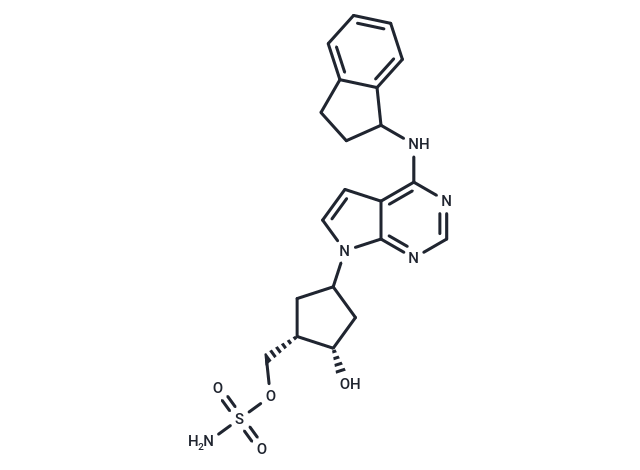Shopping Cart
- Remove All
 Your shopping cart is currently empty
Your shopping cart is currently empty

Pevonedistat (MLN4924) is a potent and selective NEDD8 activating enzyme (NAE) inhibitor (IC50=4.7 nM) with therapeutic potential for myelodysplastic syndromes (MDS) and antitumor activity.

| Pack Size | Price | Availability | Quantity |
|---|---|---|---|
| 1 mg | $48 | In Stock | |
| 2 mg | $64 | In Stock | |
| 5 mg | $97 | In Stock | |
| 10 mg | $147 | In Stock | |
| 25 mg | $272 | In Stock | |
| 50 mg | $446 | In Stock | |
| 100 mg | $755 | In Stock | |
| 1 mL x 10 mM (in DMSO) | $95 | In Stock |
| Description | Pevonedistat (MLN4924) is a potent and selective NEDD8 activating enzyme (NAE) inhibitor (IC50=4.7 nM) with therapeutic potential for myelodysplastic syndromes (MDS) and antitumor activity. |
| Targets&IC50 | NAE:4.7 nM |
| In vitro | METHODS: Nine neuroblastoma cell lines were treated with Pevonedistat (12-1000 nM) for 72 h. Cell viability was measured by MTT. RESULTS: All neuroblastoma cell lines tested were sensitive to Pevonedistat with IC50 values ranging from 136-400 nM. [1] METHODS: Human colorectal cancer cells HCT-116 were treated with Pevonedistat (0.001-3 μM) for 24 h, and the expression levels of target proteins were detected by Western Blot. RESULTS: Pevonedistat treatment resulted in a dose-dependent decrease in Ubc12-NEDD8 thioester and NEDD8-cullin couplings, leading to an increase in the abundance of known CRL substrates CDT1, p27 and NRF2. [2] |
| In vivo | METHODS: To detect anti-tumor activity in vivo, Pevonedistat (30-60 mg/kg in 10% cyclodextrin) was injected subcutaneously into BALB/c mice harboring the human colorectal cancer tumor HCT-116 either once or twice daily for twenty days. RESULTS: Pevonedistat inhibited the growth of HCT-116 xenograft tumors. [2] METHODS: To assay in vivo antitumor activity, Pevonedistat (60 mg/kg, intraperitoneal injection, once daily), venetoclax (50 mg/kg, oral administration, once daily), and azacitidine (8 mg/kg, intravenously three times every seven days) were administered to NSGS mice harboring the AML tumor OCI-AML2-Red- Fluc for fourteen days. RESULTS: Pevonedistat/venetoclax/azacitidine triple therapy induced durable responses in a systemic xenograft model of acute myeloid leukemia. [3] |
| Kinase Assay | Bcl-2 Binding affinity calculation: A predicted binding affinity for Obatoclax binding to BCL-2 is calculated using the SIE scoring function. [4] As a control in determining the reliability of the calculation, predicted binding affinities Ki) are calculated for a set of 12 small molecules with experimentally measured binding affinities to BCL-2. |
| Cell Research | MLN4924 is dissolved in DMSO and stored, and then diluted with appropriate medium before use[1]. HCT-116 cells grown in 6-well cell-culture dishes are treated with 0.1% DMSO (control) or 0.3 μM MLN4924 for 24 h. Whole cell extracts are prepared and analysed by immunoblotting. For analysis of the E2-UBL thioester levels, lysates are fractionated by non-reducing SDS-PAGE and immunoblotted with polyclonal antibodies to Ubc12, Ubc9 and Ubc10. For analysis of other proteins, lysates are fractionated by reducing SDS-PAGE and probed with primary antibodies as follows: mouse monoclonal antibodies to CDT1, p27, geminin, ubiquitin, securin/PTTG and p53 or rabbit polyclonal antibodies to NRF2, Cyclin B1 and GADD34[1]. |
| Alias | MLN4924 |
| Molecular Weight | 443.52 |
| Formula | C21H25N5O4S |
| Cas No. | 905579-51-3 |
| Smiles | NS(=O)(=O)OC[C@@H]1CC(C[C@@H]1O)n1ccc2c(NC3CCc4ccccc34)ncnc12 |
| Relative Density. | 1.62g/cm3 |
| Storage | store at low temperature,keep away from moisture | Powder: -20°C for 3 years | In solvent: -80°C for 1 year | Shipping with blue ice. | |||||||||||||||||||||||||||||||||||
| Solubility Information | DMSO: 125 mg/mL (281.84 mM), Sonication is recommended. | |||||||||||||||||||||||||||||||||||
Solution Preparation Table | ||||||||||||||||||||||||||||||||||||
DMSO
| ||||||||||||||||||||||||||||||||||||

Copyright © 2015-2025 TargetMol Chemicals Inc. All Rights Reserved.